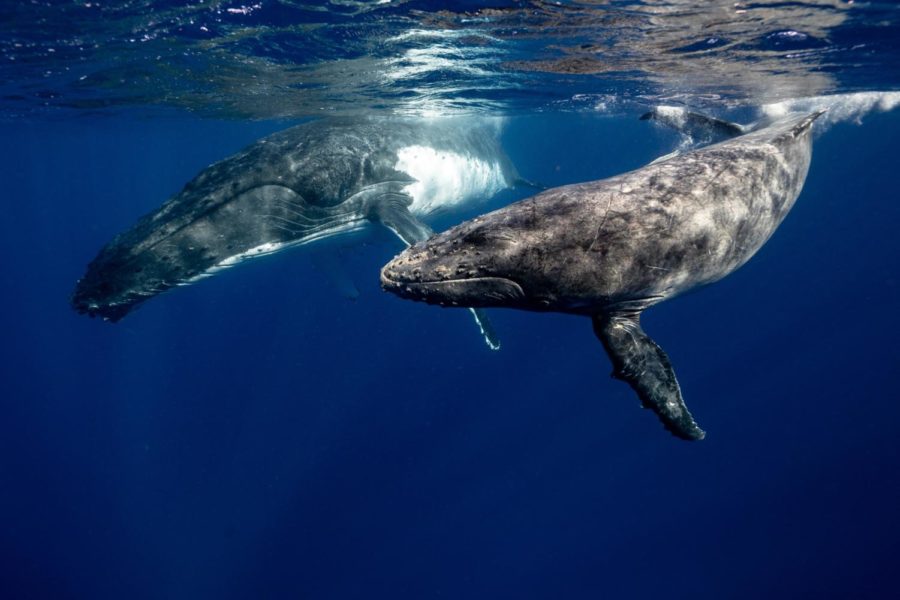The Evolution of Whales
May 27, 2021
50 million years ago the early ancestors of whales were land-dwelling animals called Pakicetus which was a four legged goat sized animal. It is hard to believe that whales are common ancestors to land mammals that roamed near the riverbanks of Pakistan and India. Pakicetus preyed on small land animals and freshwater fish. Once this species ventured into the water it evolved to be more compatible with an aquatic lifestyle which resulted in its relative Ambulocetus. This species had similar traits to Pakicetus except its feet were more webbed and acted as flippers opposed to longer legs. About 33 to 40 million years ago Dourdon was discovered, which was a 5 meter long mammal that had tiny hind legs and only lived in the water. Dourdon’s descendants are what evolved to what we know today as modern whales. The Whale and Dolphin Conservation explains that, “Hippos are the closest living relatives of whales, but they are not the ancestors of whales. Both hippos and whales evolved from four-legged, even-toed, hoofed (ungulate) ancestors that lived on land about 50 million years ago…Unlike the hippo’s ancestor, whale ancestors moved to the sea and evolved into swimming creatures over a period of about 8 million years.” The time period from Pakicetus to Dourdon was considered extremely fast in evolutionary terms. Today, there are approximately 90 different species of whales across the world.
Whales are curious creatures that travel in groups called “pods”. Typically, a pod consists of 5-30 whales but on the rare occasion there could be up to 100 whales in one pod. Whales communicate in three different ways: clicks, pulsed calls, and whistles. It is believed that whales make clicking noises to navigate and identify their surroundings. Toothed whales use a technique called echolocation to hunt their prey. Echolocation is when they send out high frequency signals to bounce off their targeted objects. Baleen whales, whales without teeth, use low frequency signals to communicate with each other over long distances. Scientists have discovered that whistles and pulsed calls are used for social activities. Each pod has a different dialect within the same population so whales can identify who is a part of their pod and who is not. Another way whales communicate is through the actions of their tail. This can be used as a scare tactic to hunt fish and also be used as a sign of aggression.
Whales are incredibly intelligent animals which is due to specialized brain cells called spindle neurons. These neurons allow for advanced abilities such as, recognizing, remembering, reasoning, communicating, perceiving, adapting to change, problem solving, and understanding. More specifically Orcas have the second largest brain in the animal kingdom after sperm whales; however, the size of their brain is not the only thing that contributes to their intelligence. Orcas rank high in cortical thickness which is a measurement of the cerebral cortex that takes account for memory, attention, language, thought, and consciousness. Another aspect that contributes to their intelligence is gyrification: the total amount of cortical nerve tissue that processes information, making brains with more wrinkles and folds more useful and efficient. This allows for quick cellular responses within the brain. Craig Welch wrote in National Geographic’s article that, “For culture to exist, individuals must come up with new ways of doing things that get shared among peers. And whales can be shrewd innovators. A few hungry sperm whales off Alaska in the late 1990s found new ways to snack: They stripped black cod off a commercial fishing boat and recorded a whale delicately grabbing a line with its massive jaw, creating tension, and then sliding its mouth up the strand until the vibrations popped off a fish.” Whales have found many unique ways to hunt for food such as disorienting fish with bubbles and also smacking them with their fluke.
Whales may be at the top of the food chain, however, 6 out of the 13 great whale species are considered endangered. Whales play a critical role in the marine environment because they produce an estimated amount of 33 tons of CO2, therefore playing their part in the fight against climate change according to the World Wildlife Fund (WWF). Approximately, 300,000 whales and dolphins are killed each year due to fisheries that catch them while others are killed from shipping and habitat loss. The WWF is working towards publishing a new initiative to protect whales and dolphins. They explain that “…The Protecting Whales and Dolphins Initiative focuses on whales and dolphins in marine environments and centers around three main pillars of activities: 1) improved monitoring and mitigation of bycatch in fishing gear; 2) reduction of underwater noise and collision risks from shipping; and 3) improved protection of critical cetacean habitats used for feeding, breeding, resting, or migration.” These next steps to whale and dolphin conservation are very promising to help protect these cetacean populations.
It is crazy to think that hippos are the closest living relatives to whales and how this species started out as a land-dwelling creature to a marine mammal. Whales have a very tight knit bond with their pods and are also clever animals that come up with innovative ways to hunt their food. There are many ways that you can help conserve the whale population such as donating to the World Wildlife Fund or taking the pledge to fight for ocean conservation.
Sources
Butler-Stroud, Chris. “How Did Whales Evolve?” Whale & Dolphin Conservation USA, 17 Oct. 2019, us.whales.org/whales-dolphins/how-did-whales-evolve/.
Henry , Leigh. “Whale.” WWF, World Wildlife Fund, www.worldwildlife.org/species/whale.
Orca Nation. “The Social Intelligence of Orcas and Their Communication.” OrcaNation, 1 Oct. 2019, www.orcanation.org/2019/10/10/the-social-intelligence-of-orcas/.
Povid, Katie. “When Whales Walked on Four Legs.” Natural History Museum, www.nhm.ac.uk/discover/when-whales-walked-on-four-legs.html.
US Department of Commerce, National Oceanic and Atmospheric Administration. “Why Do Whales Make Sounds?” NOAA’s National Ocean Service, 1 June 2013, oceanservice.noaa.gov/facts/whalesounds.





